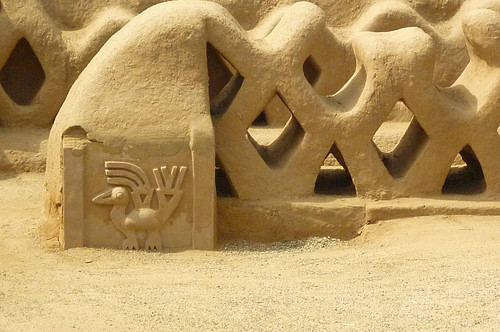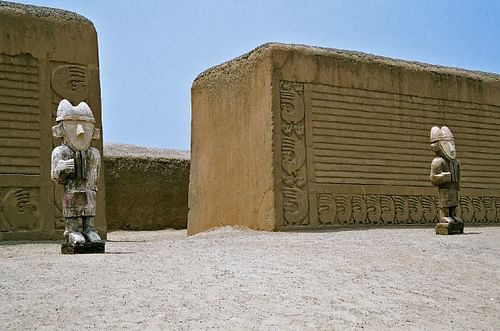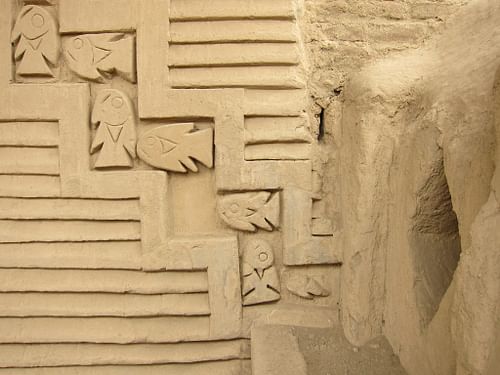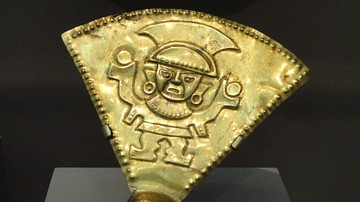
Chan Chan (Chimor) was the capital city of the Chimu civilization which flourished on the northern coast of Peru between the 12th and 15th centuries CE. The city was a giant metropolis populated by peoples from across the Chimu Empire, the largest the Americas had ever seen up to that time. Today, many of Chan Chan's huge palace complexes with their high relief-decorated adobe walls still survive as testimony to the city's lost grandeur. Chan Chan is listed by UNESCO as a World Heritage Site.
Historical Overview
Chan Chan, also known as Chimor, the name of its original inhabitants, was built at the mouth of the Rio Moche from c. 1000 CE. The initial prosperity of the Chimu was largely due to their agricultural skills as they built an extensive irrigation system using canals. Later, their successful military campaigns and policy of extracting tribute ensured that they became the dominant regional power. At its height, Chan Chan covered some 20 square kilometres and had a population of up to 40,000 making it the largest city yet seen in the Andes. The city became the hub of a vast trade and tribute network, and no fewer than 26,000 craftsmen and women resided there, often forcibly removed from conquered territories, especially the Lambayeque, to mass produce high-quality goods for domestic consumption and export. Raw materials traded and controlled by Chan Chan included gold, spondylus shell, tropical feathers, and foodstuffs.
The traditional founding ruler of the Chimu was Taycanamo, who was considered to have been born from a golden egg and then arrived from the sea. Other notable rulers include Guacricaur, who expanded into the Moche, Santa, and Zaña valleys. Eventually, the Chimu extended their territory even further south and in 1375 CE, under the rule of Nancinpinco, conquered the Lambayeque (Sican) culture absorbing some of their cultural practices and artistic ideas. The La Leche Valley was also brought under Chimu control so that, at its height, the Chimu Empire was the largest and most prosperous in South America during the Late Intermediate Period. At its greatest extent during the reign of Minchançaman c. 1400 CE, the area of Chimu influence stretched 1300 kilometres along the coast of northern Peru. As the empire grew so other administrative centres sprang up, such as at Farfan, Manchan, El Milagro, Quebrado Katuay, and the fortress site of Paramonga, but Chan Chan was supreme as the centre of the Chimu world.
Architecture
The city is without a recognisable centre and spreads out in a series of blocks interspersed with stone-lined canals and punctuated with small artificial lakes and wells. The architecture at Chan Chan is characterised by buildings constructed using pre-prepared sections of poured mud or adobe. Most impressive are the large rectangular palace compounds (ciudadelas) which served multiple functions as royal residence, storage facility, mausoleum, and administrative centre.
Ten royal palaces or compounds were constructed over the centuries at Chan Chan. It is possible that the Chimu system of royal inheritance was for each new king to inherit the title but not the wealth of his predecessor. This would result in a late ruler's family taking over the royal palace while the new king was required to build himself a new one, explaining the high number of such palaces at Chan Chan. The system has the added benefit of ensuring a new ruler actively engages in expanding the empire in order to fund his reign.
The palaces were built in a rectangular layout, each with 10-metre high double exterior walls, labyrinthine interiors, and with only a single entrance guarded by two standing wooden statues set in niches. Of special note are the U-shaped audience or ritual rooms (audiencias) which controlled access to the storerooms. These are around 4 square metres, had elevated floors and, originally, gabled roofs. Functional structures within each compound include administrative and storage buildings and burial platforms accessed by a ramp. The large T-shaped tomb within the latter contained the mummified leaders while smaller tombs their family and entourage. Such tombs would have regularly been re-opened to inter new occupants. Over time the newer palaces became larger - the biggest covers an area of 220,000 square metres - and more space was dedicated to storage, indicative of the Chimu's imperial successes and policy of extracting tribute from conquered territories.
The walls of the compounds, built to restrict access by commoners, were decorated on the outside with bold relief designs, typically repeated geometric shapes, animals, and sea life, especially fish. The interior walls had niches for wooden decorative masks and figurines. Precious art objects would have been displayed here. The distinctive patterns cut into the walls may have been in imitation of those from textile wall hangings or basketwork. Similar adobe compounds were built at other Chimu sites, for example, nine at Manchan and six at Farfan. All of the compounds at Chan Chan are in the centre of the city, while more modest habitation lies on the city's outskirts. Here were the residences for administrators in miniature versions of the larger compounds, and artisans (metalworkers, woodworkers, and weavers), who lived in more modest dwellings of wattle-and-daub and cane with steep roofs and a single hearth. Finally, on the outskirts of the city, were two large burial pyramid-mounds known as Huaca el Dragon and Huaca Tacaynamo.
The Fall of Chan Chan
Chimu architecture, their approach to regional governance, and their art would go on to influence their more famous successors, the Incas, who conquered Chan Chan c. 1470 CE. It was then that Tupac Yupanqui captured the 11th known Chimú ruler Minchançaman, who was kept permanent prisoner at Cuzco to ensure compliance to the new order. In addition, to control precious goods production and so limit the resources to fund rebellion thousands of Chan Chan artists and artisans were forcibly relocated to Cuzco. The Chimu thus became no more than a vassal state in the vast Inca Empire.
Archaeological Finds
Chimu rulers were enthusiastic collectors of art from other cultures and their palaces were like museums full of niches in which objects and statues were placed for display. So too, rulers were buried with precious objects but, unfortunately, the site has suffered extensive looting, starting with the Incas. The Spanish, for example, describe melting down a covered doorway from Chan Chan to produce 500 kilos of gold. Post-conquest, Chan Chan has also suffered from El Nino rains, which have badly eroded the adobe brick buildings and walls over the centuries, some of which are now protected by permanent roofing. Nevertheless, finds include examples of the typical Chimu blackware ceramics, commonly in the form of effigy vessels or bulbous pots with spouted handles and incised decoration of geometric patterns. Surviving metalwork in the form of such items as gold earspools, feathered tunics, pendants of inlaid shells, miniature models of funeral scenes in wood and gold, and fine cotton textiles are all testimony to the skills of Chan Chan artisans.







